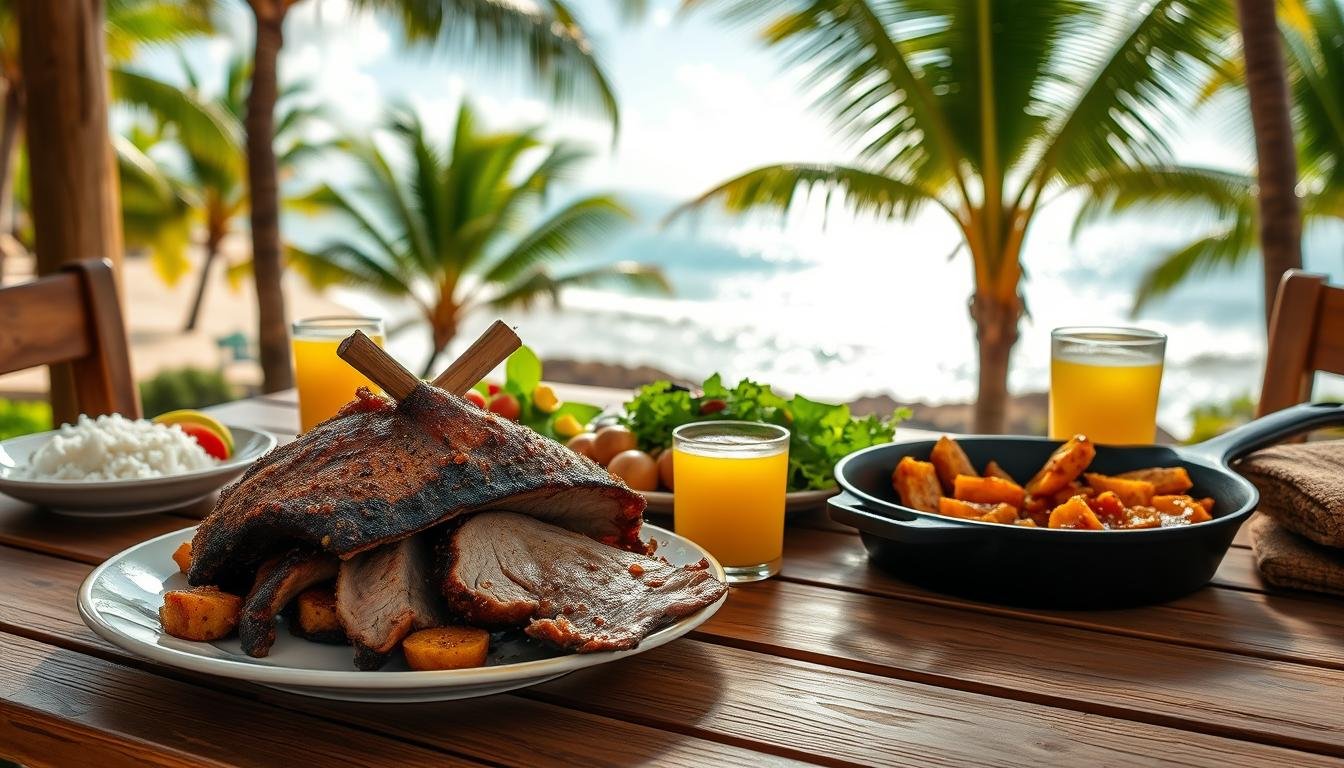The islands of Hawaii are a mix of culinary traditions. There’s a growing interest in traditional dishes like moke. This ancient cuisine uses fresh, local ingredients and blends cultural influences.
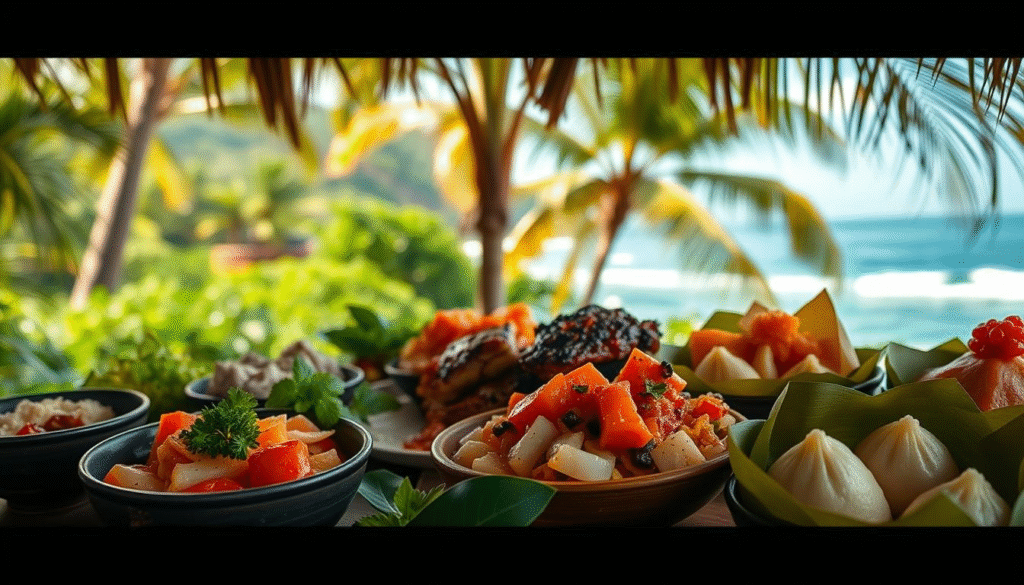
When planning your trip to Hawaii, don’t miss out on the local food. You’ll find everything from traditional Hawaiian moke recipes to modern takes on authentic dishes. Dive into the rich flavors and cultural importance of Smoke Hawaii. It’s a chance to experience the island’s unique culinary heritage.
Key Takeaways
- Explore the unique fusion of culinary traditions in Hawaii
- Discover traditional Hawaiian dishes like moke
- Experience the island’s rich culinary heritage
- Learn about the cultural significance of Smoke Hawaii
- Plan your perfect getaway with a focus on local cuisine
The Rich Culinary Heritage of Hawaii
Hawaii’s food culture is a mix of its native roots and international flavors. This mix has created a unique taste that is all Hawaiian.
Traditional Food Practices in Hawaiian Culture
Traditional Hawaiian food is a big part of the islands’ culture. People used to make meals with poi, laulau, and kalua pig. They cooked these dishes in underground ovens, called imu.
The Evolution of Hawaiian Cuisine
Hawaiian food has changed over time. It now includes flavors from Japan, China, Korea, and America. Now, you can find dishes like poke bowls and loco moco. This shows how the islands have welcomed different cultures.
| Traditional Dish | Description | Main Ingredients |
| Poi | A traditional Hawaiian dish made from fermented taro root | Taro root, water |
| Laulau | Steamed pork, beef, or chicken wrapped in taro leaves | Pork, beef, or chicken, taro leaves |
| Kalua Pig | Slow-cooked pork in an underground oven, or imu | Pork, ti leaves, sea salt |
What is Moke Hawaii? Understanding the Traditional Dish
Moke Hawaii is a dish with a deep history. It’s a key part of Hawaiian food for centuries. It’s not just food; it’s a symbol of Hawaiian culture.
Historical Background of Moke
Moke Hawaii comes from ancient Hawaiian cooking. It was made with local ingredients, showing Hawaiian people’s resourcefulness. The historical significance of Moke is in bringing people together. It’s often served at special times.
Cultural Significance in Hawaiian Communities
Moke Hawaii is important in Hawaiian communities. It represents unity and cultural identity. It’s a big part of community events.
Ceremonial Uses and Celebrations
In Hawaiian culture, Moke is more than food; it’s part of ceremonies. It’s used in:
- Traditional Hawaiian weddings
- Harvest festivals
- Cultural gatherings
Sharing Moke Hawaii at these events strengthens community bonds. It also honors Hawaiian traditions.
Essential Ingredients for Authentic Hawaiian Moke Recipe
The heart of a true Hawaiian Moke is in its ingredients. These are deeply connected to Native Hawaiian cooking. To make a real Hawaiian Moke recipe, knowing the traditional parts is key. They give the dish its special taste and cultural value.
Traditional Native Hawaiian Ingredients
At the core of authentic Hawaiian cuisine are traditional Hawaiian ingredients. For Moke, you need fresh fish like ahi or aku, seaweed, and native plants like ti leaves and kukui nuts. These ingredients make Moke taste unique and connect it to Hawaii’s rich culture.
Where to Source Authentic Components
Finding the right ingredients can be tough, mainly for those outside Hawaii. But, you can get authentic parts from local Hawaiian markets, specialty Asian stores, or online. If these options are not available, some modern swaps can keep the dish true to its roots.
Acceptable Modern Substitutions
While traditional ingredients are best, some modern swaps are okay. For example, if certain seaweed is hard to find, you can use similar types from other Pacific Islands. Knowing these swaps helps adapt the Hawaiian Moke recipe to different places while keeping its traditional Hawaiian ingredients and taste.
By choosing the right ingredients and knowing where to find or substitute them, cooks can make a genuine Hawaiian Moke. This dish honors Hawaiian cuisine’s traditions.
Kitchen Tools and Equipment for Making Moke
Getting the right tools is key to making tasty Moke. Traditional Hawaiian tools have been around for ages. But, modern tools make it easier to cook this dish.
Traditional Hawaiian Cooking Implements
Traditional tools were used to make Moke. Stone or wooden pounders were for grinding, and woven baskets for storing. These tools were vital for preparing and keeping Moke fresh.
Modern Kitchen Alternatives
Now, we have modern tools to make Moke easier. A food processor or blender can replace stone pounders. Stainless steel or glass containers are good substitutes for woven baskets. This mix of old and new makes cooking Moke more convenient.
Essential vs. Optional Tools
Some tools are must-haves for Moke, others are nice to have. You’ll need a sharp knife and a cooking pot. Optional items include a mortar and pestle or a steamer.
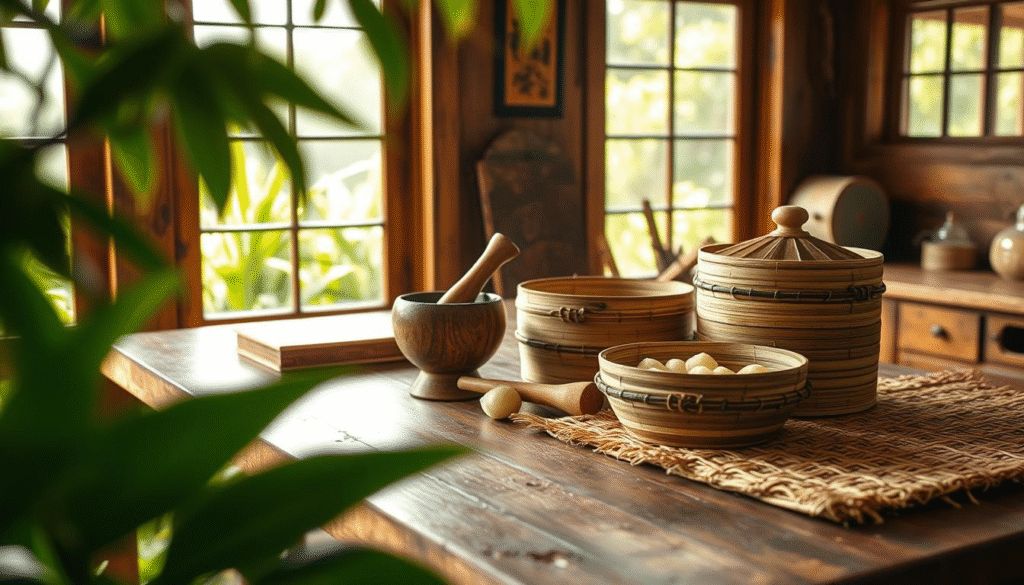
Knowing which tools are essential helps make cooking more fun and efficient.
Preparation Techniques for Moke Hawaii
To make authentic Moke Hawaii, you need to learn the preparation techniques passed down through generations. These methods are key to getting the dish’s unique flavor and texture.
Ingredient Cleaning and Processing
The first step is to clean and process the ingredients well. This means washing and cutting them to remove impurities and make them even. This ensures they cook evenly.
Proper ingredient preparation is vital for the dish’s quality. It boosts the flavor and keeps the food safe to eat.
Traditional Preparation Methods
Traditional Hawaiian cooking methods are important for Moke Hawaii. Steaming and slow cooking are used to highlight the ingredients’ natural flavors.
These traditional methods have been perfected over centuries. They are used today to make an authentic Moke Hawaii.
Time-Saving Preparation Tips
While traditional methods are important, modern techniques can also help. For example, using a food processor to chop ingredients saves time.
Also, preparing ingredients ahead and storing them properly makes cooking easier. This makes the process more efficient.
By mixing traditional techniques with modern conveniences, cooks can make a delicious Moke Hawaii. It’s both tasty and easy to prepare.
Step-by-Step Guide to Cooking Authentic Moke Hawaii
Moke Hawaii is a traditional Hawaiian dish you can make at home. This guide will help you cook it right, so you get the real taste of this beloved dish.
Step 1: Initial Ingredient Preparation
To start, prepare your ingredients. Cut fish or other proteins into the right sizes. Make sure all ingredients are fresh and of good quality for the best flavor.
Step 2: Combining and Seasoning Components
Next, mix and season your ingredients. Combine the protein with seasonings and maybe some veggies or starches. Traditional Hawaiian seasonings are key to Moke’s unique taste.
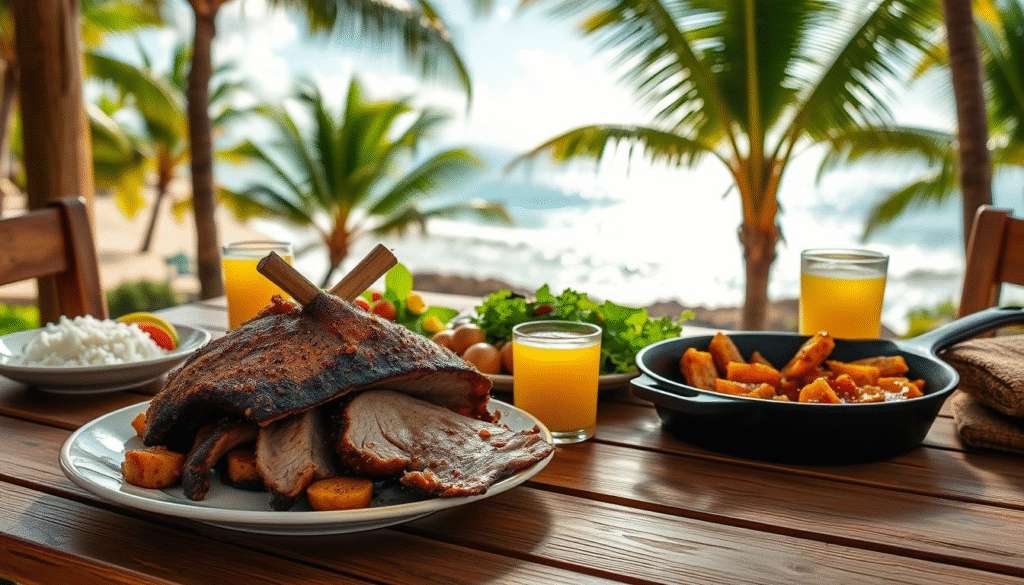
Step 3: Traditional Cooking Process
Now, cook Moke Hawaii the traditional way. This might include steaming or boiling to keep flavors and textures intact. Stick to traditional methods for that authentic taste.
Step 4: Finishing Touches and Garnishes
Lastly, add the final touches and garnishes. You might add fresh herbs, adjust the seasoning, or present it traditionally. Presentation matters to make your meal special.
| Step | Description | Key Elements |
| 1 | Initial Ingredient Preparation | Cleaning and cutting ingredients |
| 2 | Combining and Seasoning Components | Mixing protein with seasonings and other ingredients |
| 3 | Traditional Cooking Process | Steaming or boiling to retain flavor and texture |
| 4 | Finishing Touches and Garnishes | Adding fresh herbs and adjusting seasoning |
By following these steps, you can make a real Moke Hawaii dish. It will honor Hawaiian cuisine and please your taste buds.
Regional Variations of Hawaiian Moke Across the Islands
Across the Hawaiian Islands, Moke is made in unique ways. This shows local flavors and traditions. Each island has its own twist, thanks to local ingredients, cultural practices, and history.
Big Island Style Moke
The Big Island’s Moke uses locally sourced fish and seaweed from its coastlines. It also features ti leaves for wrapping. This gives the dish a special flavor.
Oahu Family Recipes
On Oahu, Moke recipes have been passed down for generations. They mix traditional and modern ingredients. Some add sesame oil or sesame seeds for extra flavor.
Maui and Kauai Interpretations
Maui and Kauai use fresh local vegetables and herbs in their Moke. These variations show off the islands’ produce and the dish’s flexibility.
The different Moke recipes across Hawaii show the islands’ creativity in cooking. They also highlight the dish’s cultural importance. Each version offers a unique taste, showing off local culture and environment.
Pairing Your Moke with Other Traditional Hawaiian Dishes
Pairing Moke with Hawaiian classics is a fun culinary adventure. To make your Hawaiian meal authentic, learn how to pair Moke with other dishes.
Complementary Side Dishes
When you serve Moke, choose side dishes that enhance its flavors. Here are some great options:
- Poi, a traditional Hawaiian staple made from fermented taro root
- Lomi salmon, a salted salmon dish mixed with tomatoes and chili peppers
- Laulau, pork or beef wrapped in taro leaves and steamed to perfection
These dishes not only go well with Moke but also add variety to your meal.
Beverage Pairings for a Complete Hawaiian Meal
No Hawaiian meal is complete without a refreshing drink. Try these:
- Traditional Hawaiian iced tea, made with local ingredients like ginger and pineapple
- Lava Flow, a fruity cocktail blending strawberry, pineapple, and coconut
- Mauna Loa coffee, a rich and smooth coffee grown on the Big Island
These drinks will make your Moke and other dishes taste even better.
Creating a Balanced Hawaiian Feast
To make a balanced Hawaiian feast, mix different flavors and textures. A good meal has:
“A balance of raw and cooked dishes, along with a mix of hot and cold items, will create a harmonious and satisfying dining experience.” –
A Hawaiian Chef
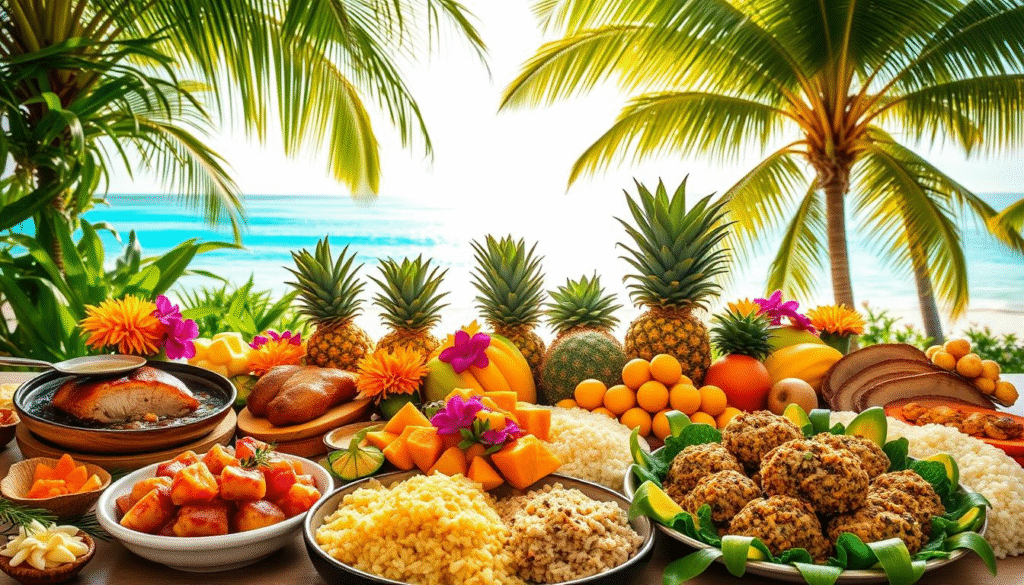
By adding a variety of traditional Hawaiian dishes, including Moke, you’ll create a memorable feast.
Common Mistakes to Avoid When Making Moke
To make a real Moke, knowing and avoiding common mistakes is key. These mistakes can mess up the flavor, texture, and quality of the dish. Making Moke, a traditional Hawaiian dish, has several steps where errors can happen.
Ingredient Selection Errors
Choosing the wrong ingredients is a big mistake when making Moke. It’s important to use fresh, high-quality ingredients. For example, picking the wrong fish or using bad salt can change the taste a lot. Sticking to traditional ingredients helps keep the dish true to its roots.
Cooking Temperature Issues
Getting the cooking temperature right is also very important. If it’s too high or too low, the texture and taste can suffer. The right temperature helps mix the flavors well and cooks the ingredients just right.
Texture and Consistency Problems
Getting the texture and consistency right is essential for Moke. If some ingredients are overcooked or undercooked, it can ruin the dish. Making sure each part is cooked correctly is the key to the right consistency.
| Common Mistake | Effect on Moke | Solution |
| Incorrect ingredient selection | Alters flavor profile | Use fresh, high-quality ingredients |
| Cooking at wrong temperature | Results in undercooked or overcooked ingredients | Maintain appropriate cooking temperature |
| Incorrect texture and consistency | Unappealing texture | Cook ingredients for the right amount of time |
Health Benefits and Nutritional Value of Moke Hawaii
Moke Hawaii is packed with essential nutrients, making it a great choice for a balanced diet. The ingredients used in Moke have been chosen for their health benefits and nutritional value over centuries.
Traditional Ingredients and Their Health Properties
Moke Hawaii includes seafood, vegetables, and sometimes seaweed. These ingredients are full of vitamins, minerals, and antioxidants. Seafood is a top-notch protein source and is rich in omega-3 fatty acids, good for the heart. Vegetables bring fiber, vitamins, and minerals. Seaweed is packed with iodine, key for thyroid health.
Adapting Moke for Dietary Restrictions
To make Moke fit different diets, you can make some changes. For gluten-free diets, make sure all ingredients are gluten-free. For low-carb diets, cut down or remove starchy veggies. Vegetarians and vegans can swap seafood for tofu or tempeh.
Incorporating Moke into a Modern Healthy Diet
Moke can be a healthy part of a modern diet with fresh, sustainable ingredients. It’s a flexible dish that can meet various dietary needs. Here’s a simple table showing the nutritional content of a typical Moke Hawaii serving:
| Nutrient | Amount per Serving | % Daily Value |
| Protein | 30g | 60% |
| Omega-3 Fatty Acids | 1.5g | 100% |
| Vitamin A | 200mcg | 20% |
| Calcium | 200mg | 20% |
Adding Moke Hawaii to your meals can make your diet both tasty and nutritious. It follows modern healthy eating guidelines.
Preserving and Storing Your Homemade Moke
Keeping your homemade Moke fresh is key to its taste and texture. The right storage keeps it safe and tasty longer. It’s all about how you store it.
Traditional Preservation Methods
Hawaiians used fermentation and drying to keep food fresh. You can ferment your Moke to boost its flavor and shelf life.
Modern Storage Techniques
Today, we have refrigeration and freezing. Store Moke in a sealed container in the fridge for a few days. Freeze it for longer. Freezing in small portions makes reheating simpler.
Reheating Tips for Optimal Flavor
Reheat Moke slowly to keep its texture and taste. Use low heat on the stovetop or the microwave with a damp cloth. A famous chef once said,
“The art of reheating is just as important as the cooking itself.”
Follow these tips to enjoy your homemade Moke longer. It will stay delicious and fresh.
Conclusion: Embracing the Authentic Flavors of Hawaii
Moke Hawaii’s story shows the rich culture of Hawaii. It highlights the islands’ unique food traditions. We’ve looked at Hawaiian food’s history and how it’s evolved.
Enjoying authentic flavors of Hawaii means diving into the islands’ culture. Moke Hawaii is a great example. It’s both tasty and good for you. It shows Hawaiian identity and community.
“The cultural significance of Moke Hawaii lies in its ability to bring people together, celebrating the islands’ heritage through every ingredient and every bite.”
Hawaiian food focuses on local and sustainable ingredients. Below, we list key Moke Hawaii ingredients and their health benefits.
| Ingredient | Health Benefit |
| Fresh Fish | High in Omega-3 fatty acids |
| Seaweed | Rich in Vitamins and Minerals |
| Local Vegetables | High in Antioxidants |
Embracing Hawaiian cuisine is more than food. It’s about culture, community, and life. Moke Hawaii is a tasty way to learn about Hawaii’s true flavors.
By embracing these flavors, we enjoy Hawaiian dishes and help keep its food heritage alive. Let’s keep exploring and celebrating Hawaii’s unique cuisine.
Sources
If you’re curious about Hawaiian cuisine and its rich culture, here are some great resources. They help you learn about traditional dishes like Moke. You’ll also get a glimpse into the islands’ cooking traditions.
Check out the Hawaii Department of Agriculture’s guide to local foods. The University of Hawaii has publications on traditional Hawaiian cuisine. Online platforms with authentic Hawaiian recipes are also worth exploring.
Want to learn more? Visit these links for more information: Hawaii Department of Agriculture, University of Hawaii Economic Research Organization, Hawaii Food Tours.
FAQ
What is Moke Hawaii?
Moke Hawaii is a traditional dish from Hawaii. It’s made with fish, seaweed, and other local items. These are cooked in traditional ways.
What are the essential ingredients for an authentic Hawaiian Moke recipe?
For real Moke, you need fresh fish, seaweed, and local ingredients. You can also use modern substitutes if needed.
How do I prepare Moke Hawaii?
Begin by cleaning and preparing the ingredients. Then mix and season them as the Hawaiians do. Finish with traditional cooking and garnishes.
What are some common mistakes to avoid when making Moke?
Avoid picking the wrong ingredients, wrong cooking temperatures, and texture issues. Stick to traditional methods and use real ingredients.
Can I adapt Moke for dietary restrictions?
Yes, you can make Moke for different diets. Just swap out ingredients and adjust cooking to fit needs like gluten-free or vegan.
How do I store and reheat homemade Moke?
Store Moke using old or new methods. Reheat it to keep the taste and quality right.
What are some regional variations of Hawaiian Moke?
Moke varies by island in Hawaii. You’ll find Big Island, Oahu, Maui, and Kauai styles. Each has its own taste.
What are the health benefits of Moke Hawaii?
Moke is good for you because of its traditional ingredients. They add nutrition and can fit into a healthy diet when cooked the right way.
